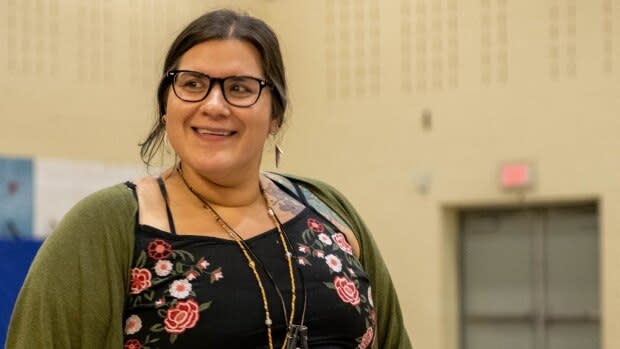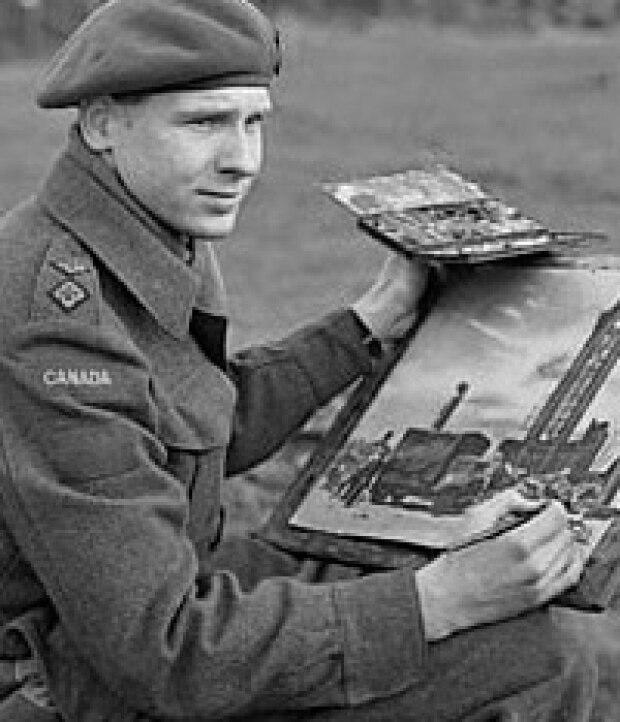Wolastoqi painter becomes UNB's first artist-in-residence in over 50 years
Natalie Sappier (Samaqani Cocahq) held a ceremony at the University of New Brunswick's Art Centre to bless the space she'll use for the next four months as artist-in-residence.
Last year, Marie Maltais of the UNB Art Centre approached Sappier and asked how she could support the multidisciplinary artist's work within the arts and Wolastoqey communities.
"I said, 'I need space,'" said Sappier, who also goes by her Wolastoquey name Samaqani Cocahq. "I need to be in the centre of the community.
"This was so perfect because, you know, I'm at a time where I'm compiling all this work and navigating through it and I need to be around my teachers, I need to be around the language, I need to be around the teachings and, you know, all the artists. So it only made sense for me to be right in the centre of it."
From this conversation came the idea for Sappier to be the artist-in-residence at the university.
The last person to fill the position was renowned war painter Bruno Bobak.
Sappier said it's "definitely an honour" to be the first artist since Bobak to do a residency at the university.
"Bruno and Molly [Bobak] have been, you know, trailblazers in the visual arts scene in the world," she said.

Sappier initially worked mainly as a painter but has employed a variety of forms to tell her "stories."
She said she doesn't yet feel as if she's "made it," since there is still much work for her to do and much more to learn, including her own Wolastoqey language.
Statistics Canada reports that fewer than 10 per cent of Wolastoqiyik can speak the language.
"I feel like a baby still because there's so much I want to learn," Sappier said. "It's going to be a lifetime journey for me to learn. And you know, all my work is focused on language now, and it's gonna take a life time for me to learn my language, and I'm really up for the journey."
Sappier said she tries to be mindful of tokenism and wants Indigenous representation to be done with sincerity.
"I think that yes, space has to be created for us, but it has to be in our terms, our voice, our way, and just support that because that's what we need."
Finding Wolastoq Voice
Following the ceremony at the UNB Arts Centre on Tuesday night, Sappier brought her Finding Wolastoq Voice show to the Chief Harold Sappier Memorial Elementary School in St. Mary's First Nation, also known as Sitansisk.
Though Sappier is known for her painting, she created a show that is a hybrid theatre performance. It features music and a story that is voiced and written by her, with the choreography of Aria Evans bringing the story to life through dance.

"The story is about a young Wolastoqi Indigenous woman who's awakened by the voices of her ancestors," Sappier said. "She goes on a journey of telling her story, her experience as a young girl, her connection with the land, her family and how she's trying to find her way."
The story is rooted in Sappier's own story and she hopes that Indigenous youth who see the performance feel encouraged to share their own stories through artistic expression.
"I thought there was an urgency for me to tell a story that would inspire us to tell our own stories," Sappier said. "But also to encourage our Indigenous youth that there is something that is really beautiful and sacred within them."
The show was developed in partnership with Theatre New Brunswick.
Sappier will be taking the show to the National Arts Centre in Ottawa for three nights, Sept. 21 to 23, as part of the Mòshkamo Story Building — Conversations on Indigenous Arts, a festival that features all Indigenous artists, including Juno winner and fellow Wolastoqi Jeremy Dutcher.
Sappier designed the backdrop for Dutcher's 2019 Juno performance.


